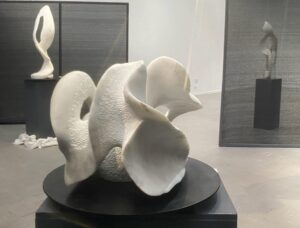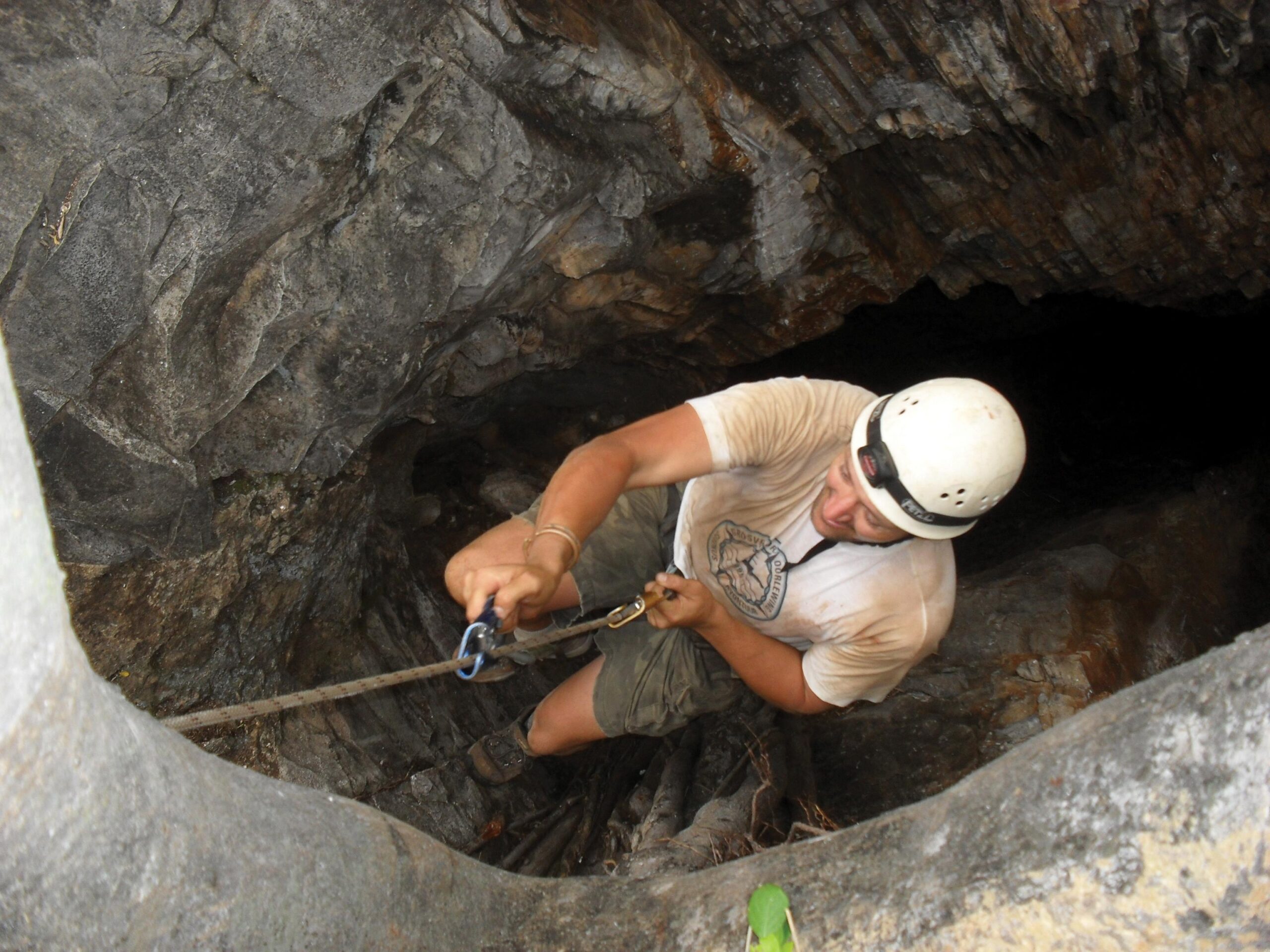

Pofadder Cave
Narrow spaces and narrow shaves
If tourists contemplate a visit to Pofadder Cave close to Grootfontein, they should be warned in advance: anyone who is afraid of the dark or has an crippling fear of confined spaces should think twice before they venture into the second largest cave in Namibia. Some prior experience of abseiling is also recommended. Luckily, although it is a very shallow cave, I realised from the outset that it would be wise to film the cave with the guidance of experts: entomologist and spelaeologist John Irish and geologist Nico Scholtz were great choices both in terms of expertise and guidance.
Text Linda de Jager | Photographs Nico Scholtz
From the Spring 2024 issue
Within moments of entering, the roots of trees growing in the cave can be seen in the probing light of the explorer’s torch. John, a frequent visitor to Pofadder Cave, was present when it was discovered in 1987. On my excursion he was therefore first to go down to show me the extensive root formations that penetrate from a wild fig growing close to the cave’s entrance. Wild fig is a tree species that loves to sprout near sink holes in order to send its roots spiralling down to the water below.
Getting to the bottom of the first chamber requires a fourteen metre abseil. The tree roots had clearly served as a handy foothold for the few visitors who have negotiated this passage before us. Bat droppings were soon noticeable and it was not long before we saw one of these cave dwellers in action. But due to the high humidity the bats are not as numerous here as they are in other caves. Like humans, bats are not comfortable when the air becomes too stuffy. A narrow fissure took us down to the first chamber.
Very soon our flashlight illuminated a treasure trove of stalagmites and stalactites. Pofadder Cave apparently also boasts unique ‘organic stalagmites’, consisting of intertwined hair roots found in places where water is constantly dripping, but at the time we were not lucky enough to find such examples. A geological wonder world awaited in chamber upon chamber, but the flashlights of course belied the pitch darkness that normally reigns here. I noticed that the Barn Owl which stayed down there during the day was the only one that appeared perfectly at ease.
Stalactites are formed from the roof of a cave and stalagmites develop from the bottom of the cave upwards. Geologist Nico Scholtz pointed out how unbelievable it is that a stalagmite was forming at the very moment that we were standing there. “If you move closer you will see that it is still wet… it is mainly calcium carbonate hardening on the cave floor… the water is saturated with calcium carbonate and as the water evaporates the calcium carbonate remains behind, forming a stalactite above us and dripping down to form a stalagmite on the cave floor,” Nico explained. “It takes hundreds of years to form. Here you come to realise the span of geological time in comparison to our lives. We think a hundred years is a long time, but in geological time it is the blink of the eye. This cave is very young – and already it is a couple of million years old.”
Nico, whose passion clearly is geology, said that he loves visiting caves because of their uniqueness. He also pointed to the combination of eeriness and beauty awaiting a visitor to this underground world, and to the fact that only a small handful of people have seen what you are witnessing. “In a time when we like to think that all wonderful sights have been discovered and seen, a cave takes your breath away,” he maintains.
John’s interest in caves is fostered by the unique forms of life that may occur down there – in these dark spaces you will usually find him on his hands and knees. To reach other chambers of Pofadder Cave you literally have to pass through a world of intertwined roots from the trees on the surface. The cave is not very deep and the roots can therefore reach far down into the cave. John pointed out that the roots are forever searching for water. Evaporating water also makes the underground atmosphere very humid. It was thrilling to observe a world literally underneath a tree, being able to see and touch the root hair that helps to absorb the water the plant needs. The thicker and larger roots found in the other chambers do not take up water directly but are part of the ‘veins’ of the tree from which the root hair sprouts.
Interestingly, this is how the cave got its name: the roots curl over the floor and as you pass them with your flashlight their shadows create the illusion that they are moving – very much like snakes. Hence the name Pofadder Cave.
One of John’s favourite bugs is a little guy with blue mouldiness on its back. It is a small beetle – known as the muf-jantjie in Afrikaans – from the same family as the tapping beetle. John said you often find them in caves, although there are also similar species living above ground. They feed on bat droppings and anything else they might find. [Muf-jantjie. No English name. Family: Tenebrionidae, Eurychora sp.]
John also pointed to an insect with exceptionally elongated legs. “This is an assassin bug. Most bugs suck plant sap but this one catches its prey and sucks its blood.” [Roofwants. Assassin bug. Family: Reduviidae]
“It is interesting to note that this cave-dwelling assassin bug is of a very light colour. Because it lives down here in the dark, it is busy losing its pigmentation,” John said. He also explained that elongated body parts are often characteristic of cave-dwelling insects. “Because they spend their lives in the dark they want to increase their area of sensitivity as much as possible, so that if anything approaches them they are aware of it as soon as possible. Therefore you find them with long, spindly legs, elongated antennae and all such manner of extensions.”
You also find other things in this cave that let your hair stand on end – like hairy worms, the larva of a moth. “Moths like dark places. They cannot survive here and have to find their food outside. But they lay their eggs down here and the eggs hatch and become worms which then become pupa and then turn into moths. At that point they have to exit the cave to find food,” John said.
Given the fact that bats and caves go together, a visitor to Pofadder Cave must also be prepared to constantly duck the cave bats. It is very warm in Pofadder Cave and all the water evaporates, but the vapour cannot escape. The relative humidity in a cave like Pofadder is up to 100 per cent – as humid as if we were placed inside a rain cloud. Add temperatures of at least 25 degrees centigrade and one understands why steam rises from everything in the cave.
Looking back in history, caves were seen as important resources during German colonial times, because in remote areas some of them were the only reliable source of fresh water. It is ironic that more than a hundred years later we are trying to establish if the same was true for Pofadder Cave. We squeezed through another couple of narrow passages looking for the hoped-for fresh water. Navigating still other narrow passages eventually led us to the ‘promised land’: the cave’s lake, so clean and blue. Nico’s words, “it took my breath away”, would soon prove to be prophetic: the water can be best described as spectacular and bluer than blue. At the time of our visit, a year of very good rains saw raised groundwater levels. Our find was therefore unique because Pofadder was not a proper lake which explorers can use for diving expeditions.
As a parting thought: the most difficult part, in addition to making your way through the narrow passages, is to climb back up and get out of the cave again. Having no prior rope ascending experience, I could barely make it back to the surface. The acute stress of struggling to climb out of the cave again would count as my low point of this caving expedition. But I had no intention of being left behind with only muf-jantjie to keep me company, not to mention being welcomed back by assassin bugs and ghost pofadders.
The highpoint of this adventure made up for the discomfort – finding the crystal blue, unpolluted water underground. This enchanting image of unpolluted purity and beauty will remain with me for the rest of my life. TN
Anyone interested in a caving adventure can contact Nico Scholtz for guided caving expeditions:
+264 81 226 2821 | ✉️
More to explore


Discover Airlines launches a new direct flight between Windhoek and Munich




Discover Airlines launches a new direct flight between Windhoek and Munich





